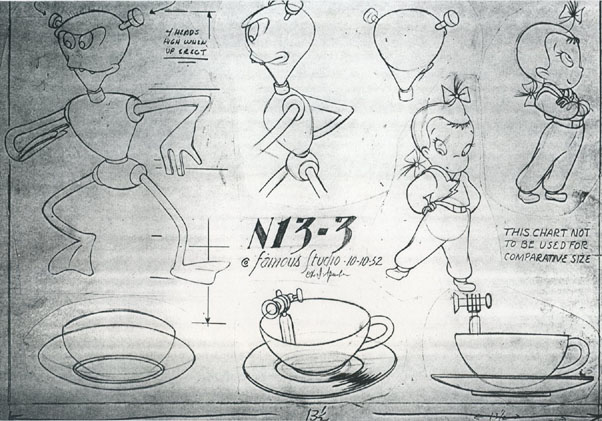
Model sheet from “Dizzy Dishes” (1955)
Another year, another order for 24 cartoons from Paramount Pictures. Not much different in their exercise of the 12th option – except a bump up in the yearly budget by $45 thousand dollars.
However you’ll note below a separate three page “Letter Agreement”, also dated March 11, 1954, which essentially grants Paramount the rights (100%) to sell Famous Studios cartoons to television. This agreement also informs Famous that Paramount will pay them $350. for each cartoon they license to TV. (Twenty one months later – in January 1956 – UM&M TV Corp. made a deal paying Paramount $3 million dollars for all its pre-1950 shorts)
This is the twelfth of fourteen (14) guaranteed options agreed to per the initial May 1942 agreement with Paramount. Will Paramount continue making cartoons with Famous Studios beyond the 14th option (ending in 1957)? Find out next week.
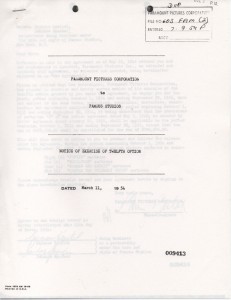

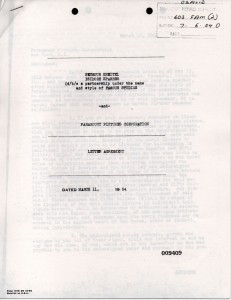
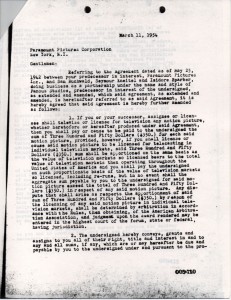
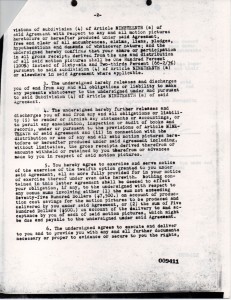


The trades were especially active in promoting shorts this year. Boxoffice magazine highlighted the Hollywood cartoons in its special “Promotion” section in November 1954; Motion Picture Herald devoted four pages (“Shorts On Parade”) in October. Motion Picture Exhibitor only gave a nod to Paramount’s sports shorts in its annual poll of the years best.
After the 3D fad of the previous season, now “wide screen” – or in Paramount’s case, “VistaVision” (projected in either 1:66 or 1:85 ratio) – was the new order of the day. (click pages below to enlarge).

Paramount’s 1954-55 trade ad for its cartoon shorts. Click above to see entire the full-page advertisement.
Let’s take a closer look at this season’s order of cartoons:
Eight (8) POPEYE cartoons
PRIVATE EYE POPEYE (11/12/54) Kneitel/Johnson. Detective spoof as Private Eye Popeye is hired to protect Olive’s emerald from a jewel thief.GOPHER SPINACH (12/10/54) Kneitel/Johnson. Popeye does battle with a gopher in his spinach garden.
COOKING WITH GAGS (1/14/55) Sparber/Johnson. Olive goes on a picnic with Popeye and April Fools prankster Bluto.
NURSE TO MEET YA (2/11/55) Kneitel/Eugster. Popeye and Bluto try to impress Nurse Olive and her charge, Swee’pea in this redo of I Likes Babies and Infinks.
PENNY ANTICS (3/11/55) Kneitel/Johnson. A “cheater” remake of a previous “cheater”, Customer’s Wanted. Popeye and Bluto, penny arcade barkers, try to lure Wimpy to their flicker machines where clips (stock scenes) from Silly Hillbilly, Wotta Knight and The Fistic Mystic play again.
BEAUS WILL BE BEAUS (5/20/55) Sparber/Johnson. Popeye and Bluto escort Olive to a day at the beach.
GIFT OF GAG (5/27/55) Kneitel/Johnson. Two of Popeye’s nephews try to sneak a gift for Popeye into his house.
CAR-AZY DRIVERS (7/22/55) Kneitel/Johnson. A remake of Wimmen Hadn’t Oughta Drive, Popeye tries teaching Olive how to drive.
Six (6) CASPER cartoons
 BOO’S AND ARROWS (10/15/54) Kneitel/Waldman. Casper helps an Indian boy, Little Feather, hunt.
BOO’S AND ARROWS (10/15/54) Kneitel/Waldman. Casper helps an Indian boy, Little Feather, hunt.
BOO RIBBON WINNER (12/3/54) Sparber/Waldman. Casper helps Molasses, an overweight greyhound, lose weight for his next race.
HIDE AND SHRIEK (1/28/55) Kneitel/Waldman. Cousin Spooky comes for a visit.
KEEP YOUR GRIN UP (3/4/55) Sparber/Waldman. At a circus, Casper saves a laughing hyena from a cruel ringmaster.
SPPOKING WITH A BROGUE (5/27/55) Kneitel/Waldman. In Ireland, Casper is mistaken for a leprechaun.
BULL FRIGHT (7/15/55) Kneitel/Waldman. Casper teaches a young bull how to win a bull fight.
Four (4) HERMAN AND KATNIP cartoons
This season Herman and Katnip suffered from the unavailability of voice actor Arnold Stang, whose radio, TV and movie career was exploding. But the loss of Stang was more than made up for with increased violence and slapstick mayhem.
Poor Katnip is encased in cement in Mouse Trapeze; is sliced in half, and gets his ass burned off in a suit of armor (in Robin Rodenthood); gets his head caught in a locomotive door, is forced to consume a ton of liquid from a water tower, and frozen alive (in Rail Rodents); and is bludgeoned with an anchor, has a pegleg replaced by a lit stick of dynamite and is shot out of a cannon (in Ship-A-Hooey).
RAIL-RODENTS (11/26/55) Tendlar/Taras. Katnip chases Herman and his nephews on a train. (Arnold Stang is absent as Herman’s voice for all four films this year)
ROBIN RODENTHOOD (2/25/55) Tendlar/Taras. Sir Katnip the tax collector versus “Robin Hood” (Herman, not voiced by Stang).
A BICEP BUILT FOR TWO (4/8/55) Kneitel/Golden. Herman tries to help Katnip bulk up to impress a gal. (Herman’s voice not Stang)
MOUSE TRAPEZE (8/5/55) Sparber/Golden. Katnip chases Herman and his nephews around a circus. (Whoever is doing Herman’s voice here is at least trying to do Stang).

Model Sheet from “Git Along L’Il Duckie”
Six (6) NOVELTOONS cartoons
An interesting year for Noveltoons as three of the six featured series regulars (Audrey, Huey and Buzzy) and three were new players .
For the regulars, each of them tackled a then-current trend. For Little Audrey is was science fiction (re-using a title from the initial Betty Boop cartroon of 1930). During the early 50s, flying saucers were spooking adults, while kids were watching Captain Video – both were spoofed in Dizzy Dishes.
It was the end of the line for the politically incorrect Buzzy – who literally goes out with a bang (and a puff) in a hilarious cartoon about another modern day taboo, the smoking habit. And Baby Huey gets his hands on a gun in another cartoon reflecting a then-current kids trend – cowboy westerns which were flooding TV screens at the time.
The trio of one-shot characters were also interesting – if a little lack-luster. “Snapper” is a bone-headed canine news photographer in a series of spot gags about taking pictures; as for “Waxey” and “Wishbone”, my guess is they were aiming for a “Tweety” like innocent who always gets the upper hand – but as a routine barnyard chase, it falls a little flat; and though “Martin Kanine” (his name a take-off from a popular radio and TV series, Martin Kane, Private Eye) had the best “script” of the trio – a clever idea about a dog becoming smarter than his master – it suffers from lead-footed direction. On the plus side, Fido Beta Kappa was an early use of incorporating Irv Spector’s angular cartoon style into the animation – a nod toward the UPA look that was taking over the field.
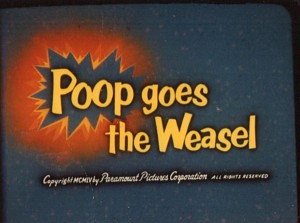 FIDO BETA KAPPA (10/29/54) Sparber/Eugster. (Martin Kanine). A pooch is sent to Dog College and returns as a genius.
FIDO BETA KAPPA (10/29/54) Sparber/Eugster. (Martin Kanine). A pooch is sent to Dog College and returns as a genius.
NO IF’S ANDS OR BUTTS (12/17/52) Sparber/Tendlar. (Buzzy). Buzzy tries to help Katsy stop smoking.
DIZZY DISHES (2/4/55) Sparber/Golden. (Little Audrey) Audrey dreams about an invasion of flying saucers.
GIT ALONG L’IL DUCKIE (3/25/55) Tendlar/Taras. (Baby Huey) Huey wants to play cowboy. Huey wants to play cowboy.
NEWS HOUND (6/10/55) Sparber/Eugster. (Snapper) Snapper will get fired from the newspaper if he doesn’t bring back a sensational photo.
POOP GOES THE WEASEL (7/8/55) Tendlar/Taras. (Wishbone and Waxey The Weasel) A weasel chases a chicken.
Below: An early storyboard for Fido Beta Kappa by Irv Spector. (click to enlarge)
(Thanks this week to Ken Layton, Art Binninger and Thad)


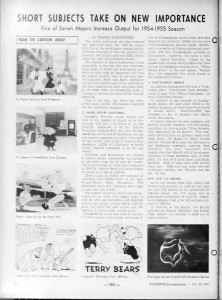
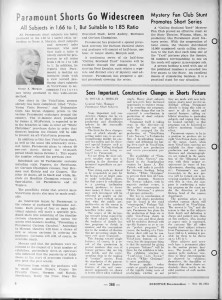
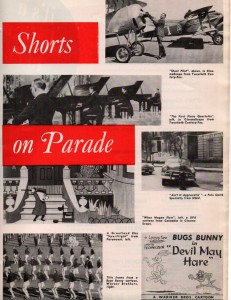
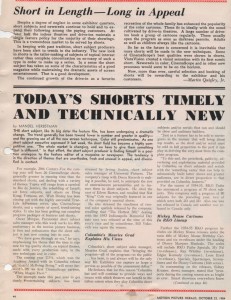

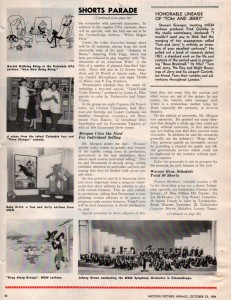
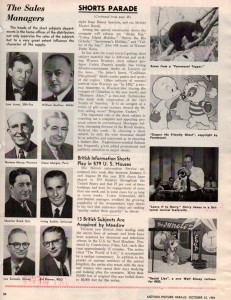
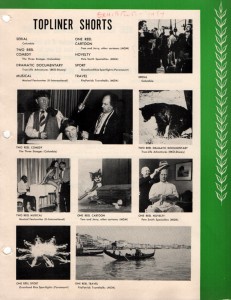

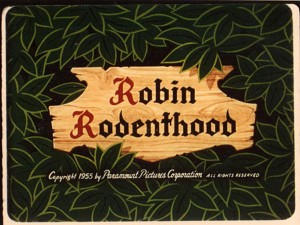
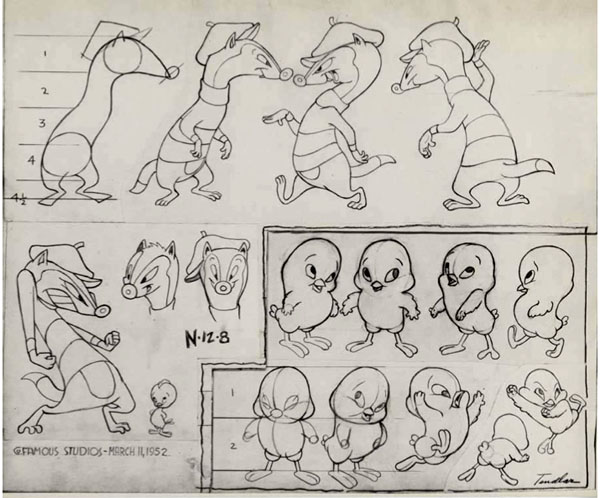
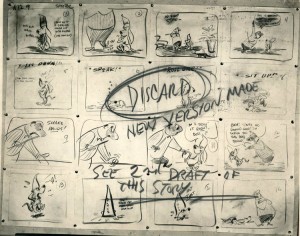



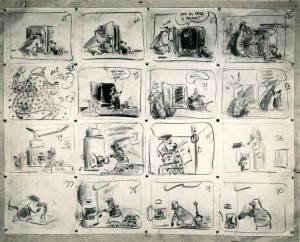

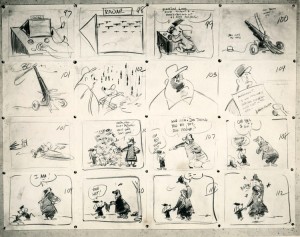


 Jerry Beck is a writer, animation producer, college professor and author of more than 15 books on animation history. He is a former studio exec with Nickelodeon Movies and Disney, and has written for The Hollywood Reporter and Variety. He has curated cartoons for DVD and Blu-ray compilations and has lent his expertise to dozens of bonus documentaries and audio commentaries on such. Beck is currently on the faculty of CalArts in Valencia, UCLA in Westwood and Woodbury University in Burbank – teaching animation history. More about Jerry Beck [
Jerry Beck is a writer, animation producer, college professor and author of more than 15 books on animation history. He is a former studio exec with Nickelodeon Movies and Disney, and has written for The Hollywood Reporter and Variety. He has curated cartoons for DVD and Blu-ray compilations and has lent his expertise to dozens of bonus documentaries and audio commentaries on such. Beck is currently on the faculty of CalArts in Valencia, UCLA in Westwood and Woodbury University in Burbank – teaching animation history. More about Jerry Beck [



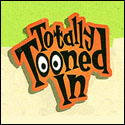



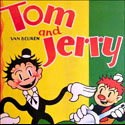
Paramount Champions reissues for 1954-55:
“We’re in the Honey”
“Butterscotch and Soda”
“Sudden Fried Chicken”
“The Friendly Ghost”
“The Bored Cuckoo”
“Santa’s Surprise”
Is Gift of Gag the Popeye cartoon where his nephews sneak a horse into his house?
I remember watching Poop Goes the Weasel on TV. When the weasel tried to kill the bulldog the chicken disguised as a rooster, I was surprised to see the chicken take the axe off the handle before it hit the dog’s head. Being a cartoon, I was expecting to see the axe go through the bulldog’s head. This disappointed me for some reason.
Well, the classic cartoon studios did have their limits. Foghorn similarly had to remove the axe when Sylvester tried to behead the dog in Crowing Pains.
Or rather, when Foghorn thought that Sylvester was trying to do that.
Andrew, the gift the nephews (2 of them) try to sneak into the house in Gift of Gag is (spoiler alert) a large box containing a “King Size” can of Spinach! The cartoon of the nephews (4 of them) sneaking a horse into the house is the first color Popeye, Her Honor, The Mare from 1943. But it’s worth pointing out that this 1955 cartoon essentially recycles the plot from the 1943 film.
And Hanna-Barbera recycled the plot of “Her Honor The Mare” for “A Seal With Appeal”, substituting a seal for the horse. (And the seal ingratiated itself to Popeye by saving his just-finished ship-in-a-bottle from being destroyed.)
DIZZY DISHES… way above average for Little Audrey, way above average for Famous in this era.
On Hide and Shriek, that was the first ever appearance of Spooky as a scrawny little ghost with a oversize toboggan cap and a childish voice (Mae Questel who also did Little Billy’s voice provided Spooky’s first voice). It wasn’t a few years later when Spooky “grew up”, got freckles, traded his oversized toboggan cap for a derby and gain a Brooklynese-Bronx like accent and became “The Tuff Little Ghost” that we knew from the Harvey comics – and still love today.
And on Spooking with a Brogue that was the only time Little Billy spoke in a Irish Brogue where he though Casper was a Leprechaun who was going to help him and his impoverish mom save thier home from a malicious miser and turns out that the miser thought Casper was a Banshee and left all his gold and money behind as he fled in terror.
IIRC, Allan Swift claimed credit for doing Herman’s voice in some interview. He was doing a few voices at Famous by this time, so it’s possible he was the one providing Herman’s voice when Stang was away in California (at least the initials of the guy doing Herman’s voice didn’t have to change).
The angular cartoon style seemed to come more out of the Al Eugster unit, showing up first in the 1953-55 period in Eugster’s one-shot cartoons like “Fido Beta Kappa” and “Crazytown” than specifically from the Spector scripts (Euster wouldn’t start sneaking the angular look into his Popeye cartoons until the 1956 release season, probably because it was easier to angular-ize a character people weren’t familiar with than it was with Popeye, Olive and Bluto). Given how evenly-timed the pacing was of Famous’ cartoons by the mid-1950s, having the characters go from their standard rounded forms into angular pseudo-UPA designs for reactions was at least one way to get the ‘takes’ to read without stretching the budget.
Bobby Bickert, Hanna-Barbera kind of recycled “HER HONOR THE MARE” two times with Auggie trying to sneak a horse into the house. I can’t recall the titles, but I enjoyed the first version the best. Also, I, too, like the LITTLE AUDREY cartoon, “DIZZY DISHES”. I’m kinda sorry that it wasn’t also put up for viewing here. Wasn’t it soon after this that Popeye tangled with alien green beings from another planet that spoke entirely in reverse? Guess that classic is coming up.
“Poop Goes the Weasel”
Ooookay . . .
This is awful, but I am enjoying the scans of BoxOffice and other trade papers here more for the “live action” shorts than the cartoons. Don’t get me wrong, I love cartoons! Yet the other shorts are ssssooooo ignored online that some of your black and white print ad scans are the ONLY “screencaps” available on the internet of such films as Warner’s “In Fourteen Ninety-Two”. (Ebay once had a full color brochure of that particular special short, since Warner promoted its travelogues much like Disney its True Life Adventures and People & Places series. I wish I had splurged on that VERY rare artifact.)
Hmm, Paramount didn’t think animated cartoons warranted VistaVision, yet UPA (and later MGM) welcomed Cinemascope.
I am surprised to read of the increase in demand for shorts in 1954 since by 1957 most short subject departments were shutting down.
I wonder just how many VistaVision shorts were produced. I too am interested in the live action short information presented here as all but The Three Stooges have disappeared from sight.
Thank you Jerry, for this wonderfully informative series.
I have counted only 11 VistaVision shorts (being a shortie junkie who gathers such silly information), the last being the popular WILLIAMSBURG: THE STORY OF A PATRIOT (filmed 1956, released 1957). Most were travelogues, including a few done with James FitzPatrick who handled MGM Traveltalks earlier.
Oooooh what the heck! It is fun talking about this stuff, even if we are going “off topic” here.
Basically we have two “death years” for the theatrical live-action short: the 1956-57 season (with stragglers like the Three Stooges the following season) and the 1971-72 season. First Hollywood thought “shorts were dead” and simply decided to “recycle” old stuff. Then theater owners complained that there were too many “reissues” being shown before the main features. Hollywood responded with a sporadic program of brand-new cheap travelogues and sports shorts to accompany the select number of cartoons still being made. Most were independent productions, but some were also “in house”. Since the 1960s was also the golden age of cinéma vérité, other distributors like Lester A. Schoenfeld had to step in to help with the demand. Just as the majors have often battled over distribution rights to Sundance Festival features in recent decades, the studios squabbled over Cannes and Venice Festival favorites in the shortie category in the sixties, even though a 70mm documentary like SKY OVER HOLLAND would get some “chopping” in order to be shown along with PETULIA at your local theater.
Paramount stuck to cartoons and occasional movie promotionals after the release of WILLIAMSBURG in 1957 (this being the same 1956-57 season that, I believe Jerry Beck will inform us, that Famous Studios became Paramount Cartoons and began slashing the budgets). Then… three years later… they struck a deal with Sports Illustrated / Leslie Winik for a series of economically produced sports-reels in 1960, beginning with the Oscar nominated “A Sport Is Born”. This marked a return to a fuller schedule of live-action shorts, mostly sports documentaries and travelogues, that lasted through the 1968-69 season (a year after the final cartoons with Ralph Bakshi involved).
This pattern resembles a few other studios, only MGM curtailed earlier than Paramount after the Pete Smith series ended in 1955 and only had a few CinemaScope specials to accompany Tom & Jerry for the ’55-56 season. Then, of course, we have that “gap” between Hanna & Barbera and Gene Dietch.
RKO ended in 1957… shorts AND (for the most part) features as well. Their post-Howard Hughes (’55-57) black and white Sportscopes and Screenliners get aired on TCM today.
Warner Brothers boasted the best (and most Oscar nominated) live-action shorts… and so they went in decline in very high style. The Joe McDoakes, Robert Youngson documentaries and Sports Parades (all excellent productions quality-wise right through the end) were phased out in ’56 along with the Pathé newsreel, while the CinemaScope travelogues with André De La Varre continued the following season (’57) before he had to return to the Burton Holmes company that was struggling at that time. Then there were “featurette specials”, 30-40 minutes in length and always well-done, released on an unpredictable schedule much like the Disney “specials” of the same period. Concurrent to these were the Bell Science TV specials with Frank Baxter, done at Warners in the 1958-61 with longtime shorts director Owen Crump supervising. Throughout the sixties, Warner released at least 5 or so live action travelogues annually under its “World Wide Adventures” logo, some independently produced and some “in house”. William Hendricks, who produced Cool Cat also produced films about race cars, Hollywood celebrity functions and trips to Austria through the 1969-70 season (post Cool Cat).
20th Century Fox was consistent with both its newsreel and CinemaScope travelogues through 1964, then it was just movie promotionals and Terrytoons though ’68.
Universal focused exclusively on documentaries (including their popular Color Parade and Vistirama travelogues) and Walter Lantz after their big band musical featurettes ended in 1957, but their schedule was pretty consistent through spring ’72. Each Woody Woodpecker was alternated with a ten minute “brand new” live-action short on European sight seeing or kiddie baseball.
Ditto Columbia. UPA was merely replaced by Hanna-Barbera’s Loopy De Loop and imports from the National Film Board of Canada. The Three Stooges were gone after Jules White stormed into Harry Cohn’s office in late ’57 to announce that he thought the shorts market was tanking. Yet even after Cohn’s death a few months later, the sports documentaries and travelogues continued, if at a more uneven rate of 2-5 a year, through 1971-72. Also Columbia cornered the 16mm school market with their Learning Corporation of America, which released some shorts theatrically in the seventies as well.
Only United Artists still had DePatie-Freleng cartoons after this point, but their live-action shorts were always independent productions anyway.
You can see all of the studio SERIES profiled here: https://en.wikipedia.org/wiki/List_of_short_subjects_by_Hollywood_studio
Paul and JLewis – I too am fascinated by this period of shorts (all the way till UA stopped distributing them in the 1980s!). I actually believe the changing screen ratio in 1953 was a savior for shorts producers. Now that the screens were 1:85 or CinemaScope, simply reissuing old cartoons was not good enough. MGM in particular, I believe, would have shut the doors a lot sooner if not for an exhibitor demand wide-screen Tom & Jerry shorts.
Cartoons were so ingrained as part of the movie program, I still recall my parents expecting a cartoon before the movie in the 1960s. It’s not unlike modern audiences expecting to see five trailers in front of a film today. It’s simply part of the moviegoing ritual.
We can also add that those of us belonging to the Baby Boom and Generation X (born circa 1946-76) benefited from a great many 16mm shorts (sometimes released on 35mm to theaters) shown in public schools before VHS and computers replaced them. Much of the “new” National Film Board of Canada and Encyclopædia Britannica product (both live action and animated) was just as good as the Hollywood studio product of earlier decades.
I wonder what the old openings looked like on these cartoons. I seen the Noveltoon’s Jack and the box opening on this seasons cartoons and it looks completely tiny. The screen cuts off a lot of the cel so that it could be shown in vistavison. I wonder how the titles of “Dizzy Dishes” looked with the original Paramount Titles. I sespcect that the cartoons with the spinning star intros(Audrey and Popeye) looked better and I sespect that Dishes uses the widescreen logo